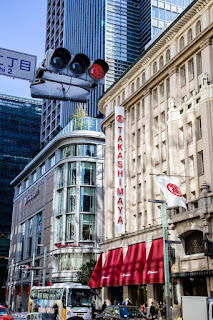Wikilatief - In international law under the Vienna Convention on the road Signs and Signals states that a red light means stop and green means road/drive.
While the traffic lights in Japan use striking red and blue colors. Why not green?
Why are the traffic lights in Japan blue, yellow and red?
Language Journey
Every country must have its own culture, including its language. For example, Japanese people have different languages to refer to light blue and dark blue.Read too : Why is the birth rate in Japan so low?
Once the color is red, there are green, and then yellow, as well as other colors. But it's different from the language in Japan.
 |
| . |
Language Affects The Color of Traffic in Japan
After some time using these 4 color terms, then in the first millennial period, came the term midori used to mention to green.But the meaning of midori for the Japanese is still difficult to remember and always overshadowed by blue (ao).
Read too : The history of the invasion of Mongol troops to Japan. Has Japan experienced a culture shock?
They are still often switched to mention green (midori) to blue (ao). Because of the habit of mentioning this often wrong color, finally the traffic lights in Japan that were once green were changed to blue.
Based on information taken from the Japan Times, it turns out that the blue traffic light happened because it had something to do with the language problem there.
Based on information taken from the Japan Times, it turns out that the blue traffic light happened because it had something to do with the language problem there.
Hundreds of years ago, Japanese only had a term for 4 colors. Black, white, red, and blue (ao).
The green color itself, which has a characteristic resemblance to the color blue is also called ao. So, arguably, blue and green are the same colors in Japan.
Red is used to refer to colors with a warm hue and blue is used to refer to colors with a cool hue.
Therefore, the color blue or 'ao' in Japanese, is also used to refer to objects that are green.
So, green fruits, vegetables, and seaweed are also known as 'ao' in front of him, friends.
In fact, even though there is already its own word for green, the word 'ao' is still used to point to objects that is greened.
In 1973, the Japanese Government stipulated that traffic lights should be green. However, the green color is still the green color closest to the blue color, friends.
The blue color we see at Japanese traffic lights is still eligible to be referred to as green.
So, the green color on the lights in Japan is still eligible to be referred to as the color 'ao', but it is also green enough for migrants from abroad.
But, there are rules that still use blue, yes, that is, when someone conducts a test to get a driver's license, they must pass an eye examination.
In the eye examination there is a test that requires the driver to be able to distinguish the colors red, yellow, and blue.
However, in order for the color of traffic lights used in Japan in accordance with international agreements, the Japanese government made blue lights that are the closest color to green.
Red is used to refer to colors with a warm hue and blue is used to refer to colors with a cool hue.
Therefore, the color blue or 'ao' in Japanese, is also used to refer to objects that are green.
So, green fruits, vegetables, and seaweed are also known as 'ao' in front of him, friends.
In fact, even though there is already its own word for green, the word 'ao' is still used to point to objects that is greened.
Traffic Light Color Rules in Japan
In 1968, many countries in duia agreed to the Vienna Convention on international traffic signs, friends. However, the Japanese state did not sign it.In 1973, the Japanese Government stipulated that traffic lights should be green. However, the green color is still the green color closest to the blue color, friends.
The blue color we see at Japanese traffic lights is still eligible to be referred to as green.
So, the green color on the lights in Japan is still eligible to be referred to as the color 'ao', but it is also green enough for migrants from abroad.
But, there are rules that still use blue, yes, that is, when someone conducts a test to get a driver's license, they must pass an eye examination.
In the eye examination there is a test that requires the driver to be able to distinguish the colors red, yellow, and blue.
(Why are the traffic lights in Japan blue, yellow and red ?)
Images sources : pixabay.com
